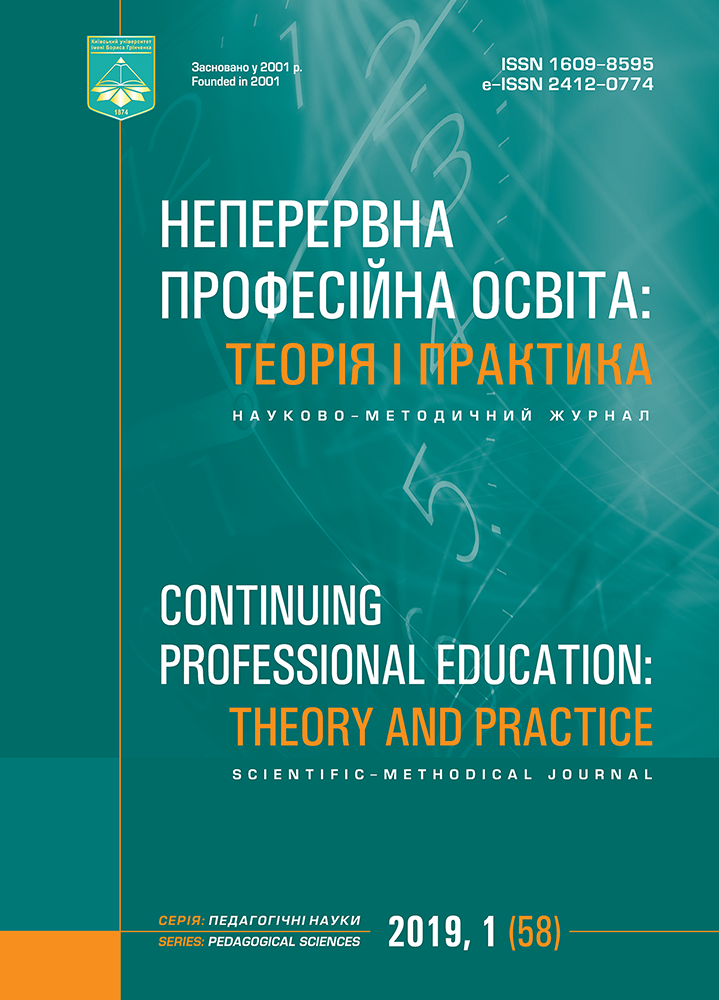PRODUCTIVE LEARNING TECHNOLOGY AS MEANS OF EDUCATION QUALITY PROVISION
DOI:
https://doi.org/10.28925/1609-8595.2019.1.4245Keywords:
education quality, productive learning technology, educational technology, learning culture.Abstract
This article presents a review that provides insight in the concept, characteristics of productive learning in its correlation with education quality as well as the purposes of a productive learning environment. The problem of education inner and outer quality in higher educational establishments has been highlighted. The most important inner and outer components of productive learning as well as main turning points of productive learning history and basic definitions have been succinctly studied. This article defines three the most important components of a Productive Learning both inner and outer: 1) learning opportunity that helps to a select number of relevant learning choices, not a high volume and variety; 2) learning capability that helps to gain competences not just new business skills and knowledge; 3) learning environment that is necessary to share ownership of the learning environment, not just their individual learning. Thus, technology can play a key role in education quality provision.References
Ballantyne, R., & Packer, J. (2009). Introducing a fifth pedagogy: Experience-based strategies for facilitating learning in natural environments. Environmental Education Research, 15 (2), 243–262 (eng).
Corte, E. D. (2000). High-powered learning communities: A European perspective. Paper presented at the First Conference of the Economic and Social Research Council’s Research Programme on Teaching and Learning, Leicester, UK (eng).
Сorte, E. D., Verschaffel, L., & Masui, C. (2004). The CLIA-model: A framework for designing powerful learning environments for thinking and problem solving. European Journal of Psychology of Education, 19 (4), 365–384. DOI: 10.1007/BF03173216 (eng).
Deemer, S. (2004). Classroom goal orientation in high school classrooms: Revealing links between teacher beliefs and classroom environments. Educational Research, 46 (1), 73–90 (eng).
Felner, R. D., Seitsinger, A. M., Brand, S., Burns, A., & Bolton, N. (2007). Creating small learning communities: Lessons from the project on high-performing learning communities about «What Works» in creating productive, developmentally enhancing, learning contexts. Educational Psychologist, 42 (4), 209–221 (eng).
Fiszer, E. P. (2004). How teachers learn best: An ongoing professional development model. Lanham, MD, USA: Scarecrow Education (eng).
Fjuk, A., & Berge, O. (2005). Case: Learning the process of programming through ICT mediated apprenticeship. An Activity Theoretical Approach. In L. Dirckinck-Holmfeld (Ed.), Report on theoretical framework on selected core issues on conditions for productive learning in network learning environments (pp. 37–47). Lausanne, Switzerland: European Commission, DG INFSO (eng).
Gerjets, P. H., & Hesse, F. W. (2004). When are powerful learning environments effective? The role of learner activities and of students’ conceptions of educational technology. International Journal of Educational Research, 41 (6), 445– 465. DOI: 10.1016/j.ijer.2005.08.011 (eng).
Kester, L., Kirschner, P., & Corbalan, G. (2007). Designing support to facilitate learning in powerful electronic learning environments. Computers in Human Behavior, 23 (3), 1047–1054. DOI: 10.1016/j.chb.2006.10.001 (eng).
Sharan, S., & Tan, I. G. C. (2008). Organizing schools for productive learning. Retrieved from http://www.springerlink. com/content/x7n625/#section=153151&page=1 (eng).
Smeets, E. (2005). Does ICT contribute to powerful learning environments in primary education? Computers & Education, 44 (3), 343–355. DOI: 10.1016/j.compedu.2004.04.003 (eng).
Stager, G. S. (2005). Papertian constructionism and the design of productive contexts for learning. Paper presented at the EuroLogo X, Warsaw, Poland. Retrieved from http://stager.org/articles/eurologo2005.pdf (eng).
System of higher education quality provision. Retrieved from http://academy.gov.ua/?lang=ukr&tip=dop&tipn=Page &page=195 (eng).
Understanding education quality. EFA Global monitoring report. Retrieved from http://www.unesco.org/education/ gmr_download/chapter1.pdf (eng).
Wentzel, K. R. (1998). Social relationships and motivation in Middle School: The role of parents, teachers, and peers.
Journal of Educational Psychology, 90 (2), 202–209 (eng).
What is productive learning? Productive learning and common understanding in Proved. Retrieved from http://www. iple.de/PROVED/documents/teacher/What%20is%20PL.pdf (eng).
Downloads
Published
How to Cite
Issue
Section
License
Copyright (c) 2020 Elena Kolomiiets

This work is licensed under a Creative Commons Attribution-NonCommercial 3.0 Unported License.



